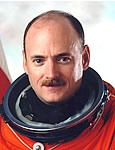
Lyndon B. Johnson Space Center
Houston, Texas 77058

 |
National
Aeronautics and Space Administration
Lyndon B. Johnson Space Center |
 |
Biographical Data |
||
Scott J. Kelly (CAPTAIN, USN)
NASA Astronaut
PERSONAL DATA: Born February 21, 1964 in Orange, New Jersey. Married to the former Leslie S. Yandell of Atlanta, Georgia. They have two children. His parents, Richard and Patricia Kelly, reside in League City, Texas.
EDUCATION: Graduated from Mountain High School, West Orange, New Jersey, in 1982; received a Bachelor of Science degree in electrical engineering from the State University of New York Maritime College in 1987, and a Master of Science degree in aviation systems from the University of Tennessee, Knoxville, in 1996.
ORGANIZATIONS: Associate Fellow, Society of Experimental Test Pilots and Member, Association of Space Explorers.
SPECIAL HONORS: Defense Superior Service Medal, Navy Commendation Medal, Navy Achievement Medal, 2 Navy Unit Commendations, National Defense Service Medal, Southwest Asia Service Medal, Kuwait Liberation Medal, Sea Service Deployment Ribbon, 2 NASA Space Flight Medals, NASA Exceptional Service Medal, Korolev Diploma from the Federation Aeronautique Internationale, 1999. Honorary Doctorate of Science degree from the State University of New York, 2008.
EXPERIENCE: Kelly received his commission from the State University of New York Maritime College in May 1987, and was designated a naval aviator in July 1989 at Naval Air Station (NAS) Beeville, Texas. He then reported to Fighter Squadron 101 at NAS Oceana, Virginia Beach, Virginia, for initial F-14 Tomcat training. Upon completion of this training, he was assigned to Fighter Squadron 143 and made overseas deployments to the North Atlantic, Mediterranean Sea, Red Sea and Persian Gulf aboard the USS Dwight D. Eisenhower (CVN-69). Kelly was selected to attend the U.S. Naval Test Pilot School in January 1993 and completed training in June 1994. After graduation, he worked as a test pilot at the Strike Aircraft Test Squadron, Naval Air Warfare Center, Aircraft Division, Patuxent River, Maryland, flying the F-14 Tomcat and F/A-18 Hornet. Kelly was the first pilot to fly an F-14 with an experimental digital flight control system installed and performed subsequent high angle of attack and departure testing.
Kelly has logged over 4,000 flight hours in more than 30 different aircraft and has over 250 carrier landings.
NASA EXPERIENCE: Selected by NASA in April 1996, Kelly reported to the Johnson Space Center in August 1996. Following completion of training, he was assigned technical duties in the Astronaut Office Spacecraft Systems/Operations Branch. A veteran of two space flights, Kelly has logged over 497 hours in space. He served as pilot on STS-103 in 1999, and was the mission commander on STS-118 in 2007. Following STS-103, Kelly served as NASA’s Director of Operations in Star City, Russia. He served as a back-up crewmember for ISS Expedition-5 and as the Astronaut Office Space Station Branch Chief. Currently he is training as the commander of ISS Expedition-26, scheduled to launch in late 2010.
SPACE FLIGHT EXPERIENCE: STS-103 (December 19-27, 1999) was an 8-day mission during which the crew successfully installed new instruments and upgraded systems on the Hubble Space Telescope (HST). Enhancing HST scientific capabilities required three space walks. The STS-103 mission was accomplished in 120 Earth orbits, traveling 3.2 million miles in 191 hours and 11 minutes.
STS-118 (August 8-21, 2007) was the 119th space shuttle flight, the 22nd flight to the station, and the 20th flight for Endeavour. During the mission Endeavour's crew successfully added another truss segment, a new gyroscope and external spare parts platform to the International Space Station. A new system that enables docked shuttles to draw electrical power from the station to extend visits to the outpost was activated successfully. A total of four spacewalks (EVAs) were performed by three crew members. Endeavour carried some 5,000 pounds of equipment and supplies to the station and returned to Earth with some 4,000 pounds of hardware and no longer needed equipment. Traveling 5.3 million miles in space, the STS-118 mission was completed in 12 days, 17 hours, 55 minutes and 34 seconds.
SEPTEMBER 2008